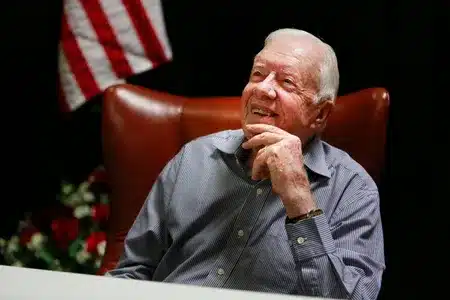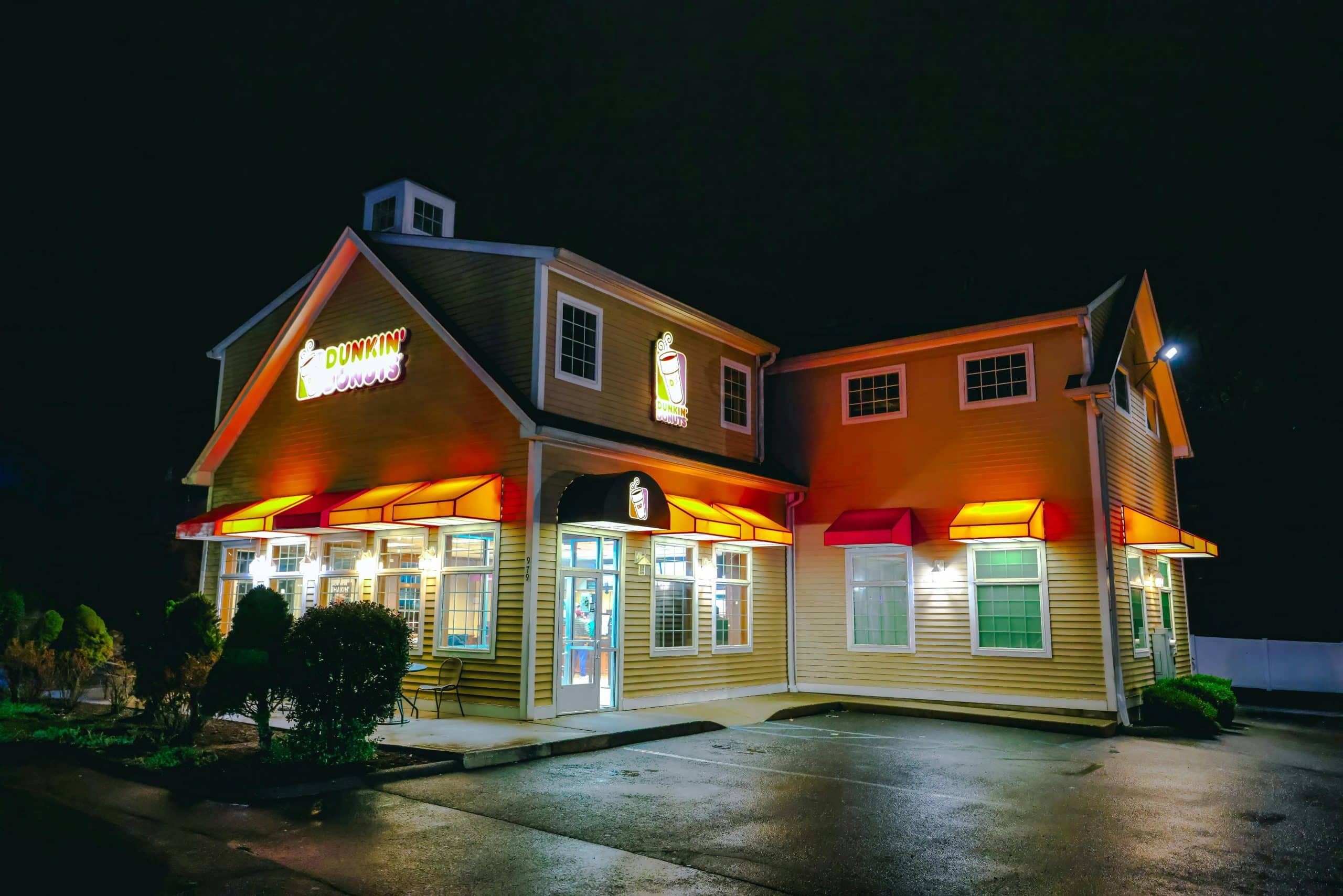Happy Birthday to our longest-living president. Yesterday was President Jimmy Carter’s 100th birthday. Although his health has taken a turn for the worse, he still resides in his hometown of Plains, Georgia. He has vowed to live long enough to vote for Kamala Harris for President.
As President Carter celebrates his monumental birthday, it is a great time to reflect on his accomplishments and how he has always worked to improve the conditions of those less fortunate.
It Started in Plains Georgia
James Earl Carter Jr. was born in Plains on October 1, 1924. He attended Plains High School, where he played on the basketball team. After high school, Jimmy then attended a couple of local colleges before realizing his dream of being admitted into the United States Naval Academy.
While at the academy, he would meet a friend of his sisters, Rosalynn Smith, whom he married in 1946. In 1947, Carter graduated from Annapolis 60th out of 821 midshipmen and was commissioned as an ensign.
Early Naval Career
For the next seven years, the Carters would move frequently, stopping in Virginia, Hawaii, Connecticut, California, and New York. His first assignment was in submarines, where he was mentored by Hyman G. Rickover, the head of the Navy’s new nuclear submarine program.
He was then assigned to nuclear power plant operations, where he assisted in the reactor shutdown at the Chalk River Laboratories plant. In July 1953, Carter’s father died of pancreatic cancer, and he asked for and received his release from active duty to return to Plains and manage the family’s peanut business.
Peanut Farmer and Politician
The first few years back in Plains were a struggle, but eventually, the Carters grew the business and became quite successful. Racial tensions grew in Plains after the 1954 Supreme Court of the United States decision in Brown vs. Board of Education. Jimmy supported equal rights and integration, and in 1962, he ran for an open Georgia State Senate seat.
Carter won the seat and became a strong supporter of President John F. Kennedy. When a political opponent, Bo Callaway, was elected to the U.S. House, Carter made plans to challenge him in the next election. Callaway instead announced his candidacy to become Georgia’s next governor. When this news hit, Carter changed his plans and ran for the statehouse.
The Race for Governor
Carter lost his first bid for the Georgia governor’s seat in 1966. The eventual winner was staunch segregationist Lester Maddow, which lit the flame even higher within Jimmy. Bolstered by declaring himself a born-again Christian, Jimmy spent the ensuing four years planning his next campaign.
In 1970, Jimmy first defeated Carl Sanders in the Democratic primary and Republican Hal Suit in the general election. Carter was criticized during his second campaign for reaching out to segregationists like Alabama Governor George Wallace, but his tone changed after the election.
Governor Carter and Planning for the Presidency
Governor Carter’s administration had two major goals: reducing government waste and elevating civil rights. To solve the first issue, he reorganized Georgia State Departments and pushed for a significant budget cut for each department. For the latter goal, he worked with the legislature to provide equal state aid to all of Georgia’s schools, set up community centers for mentally disabled children, and increase education programs for convicts.
Carter was facing a term limit, so he refocused his goals on the national political scene. He attended the 1972 Democratic National Convention to make important contacts. He was also named to the Trilateral Commission and chairman of the Democratic National Committee’s congressional and gubernatorial campaigns. All of this set the stage for 1976.
Presidential Campaign
Jimmy Carter announced his candidacy for president on December 12, 1974. A heavy underdog among 16 candidates, he decided to introduce himself to the American public. His name recognition grew, as did his popularity. Post-Watergate, he played up his status as the ultimate Washington outsider.
Jimmy started the election year well, winning the Iowa caucuses and the New Hampshire primary. George Wallace provided only nominal opposition. He accepted his party’s nomination that year and named Minnesota Senator Walter Mondale as his running mate.
Jimmy and President Gerald Ford debated three times, and Jimmy’s commanding double-digit lead in the polls had eroded, and the race appeared to be even on election day. In the end, Carter won 297 electoral votes to Ford’s 240. Strong support from the African-American community was a huge factor in his victory
Carter Presidency

Things started roughly for the Carter administration. The theme of being an outsider also applied to his senior White House staff, who were named the “Georgia Mafia.” Lacking any Washington experience, his administration never won over Capitol Hill, the national press corps, or Washington’s social scene. Because of his poor relations with Congress, it became difficult to get policy planks into law. As president, one of his main goals was to lessen the country’s dependence on foreign oil, But the Iranian Hostage Crisis caused gas shortages and long lines at the pump.
Some of his foreign policy initiatives were the highlights of his presidency. Making human rights a centerpiece of his international work, he suspended economic and military aid to Chile, El Salvador, and Nicaragua in protest of the human rights abuses propagated by those governments. But, his most important foreign policy achievement was his mediation of the 1978 Camp David Accords between Egypt and Israel. This led to the historic treaty whereby Israel withdrew from the Sinai Peninsula, and the respective governments recognized each other’s right to exist.
However, his undercover negotiations to return the Panama Canal to Panama made him appear weak and ineffectual. But the Iranian student takeover of the United States Embassy in February 1979 was the crushing blow to his presidency. Failure to negotiate the release of the 66 American hostages and the botched rescue attempt put the U.S. and the hostages through 444 days of hell.
And the ultimate indignation was that just a few hours after Ronald Reagan took the oath to become the nation’s 40th president, the flight taking the remaining 52 hostages took off from Tehran bound for West Germany. The Reagan administration basked in the glory of their release, while President Carter and his staff were largely forgotten during the celebration.
Post Presidential Life
The pattern for most past presidents of this era was to go home, make a few public appearances, build their library, and slowly fade from the public eye. Jimmy Carter would have none of that. Starting in 1984, Jimmy and Rosalyn donated one week of their time and building skills to Habitat for Humanity. They led a major volunteer-building event every year that attracted thousands of volunteers. One year, it was in the U.S., and the next year, it would be overseas. The Carter Work Project has helped over 59 million people achieve stability and independence through safe and affordable housing.
In 2002, Carter received the Nobel Peace Prize “for his decades of untiring effort to find peaceful solutions to international conflicts, to advance democracy and human rights, and to promote economic and social development.” And in 1982, The Carter Center was founded by Jimmy and Rosalyn in partnership with Emory University, with a commitment to human rights, reducing human suffering, preventing and resolving conflicts, and enhancing democracy worldwide.
His dear Rosalyn passed away last year, and he has been in hospice for a year and a half, but his spirit and passion are as strong as ever. Happy Belated Birthday, Mr. President; here’s to a job well done.








